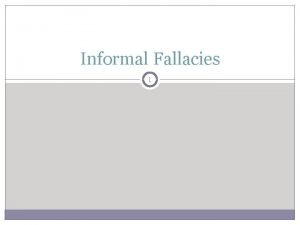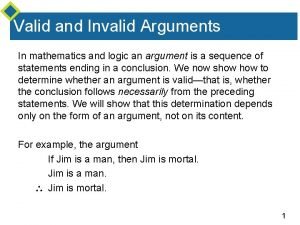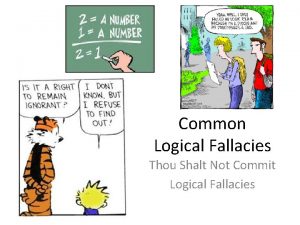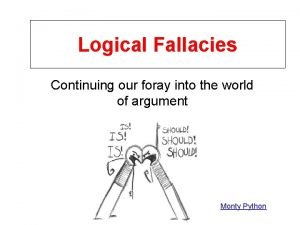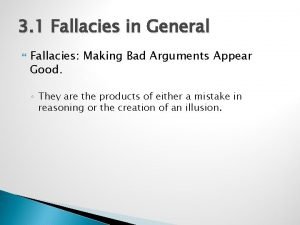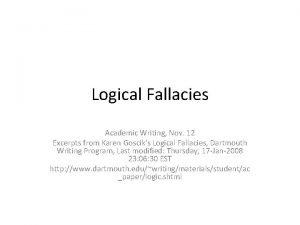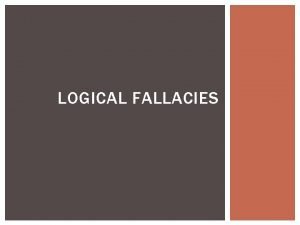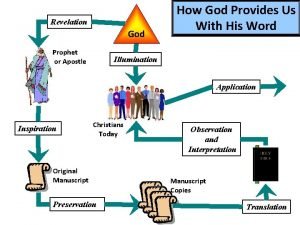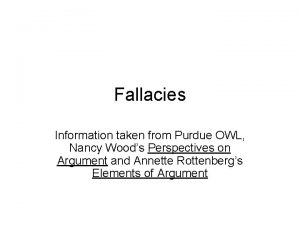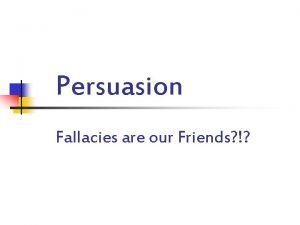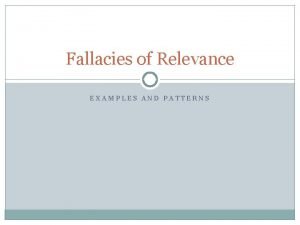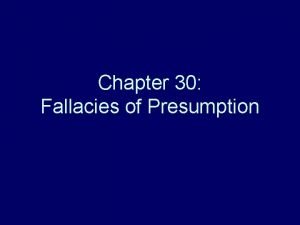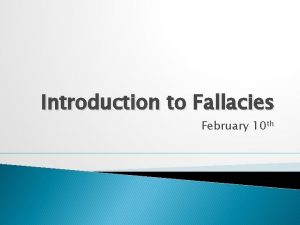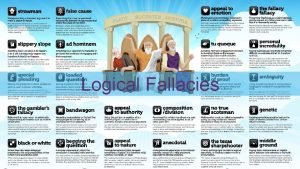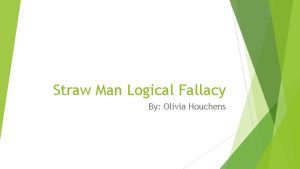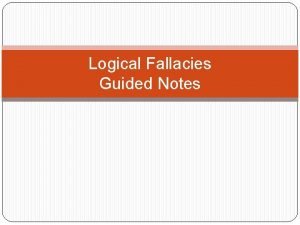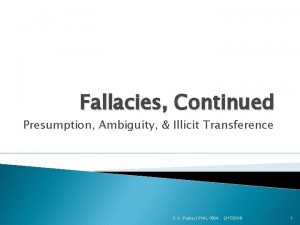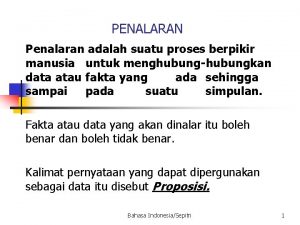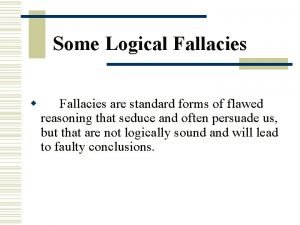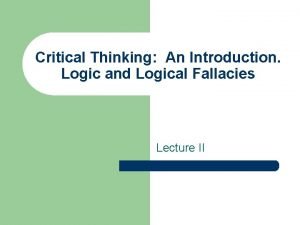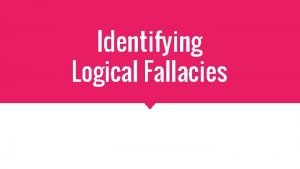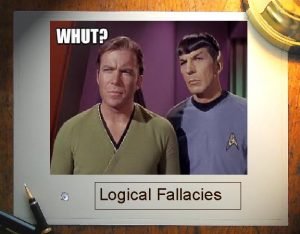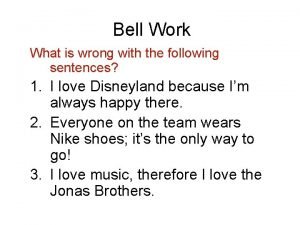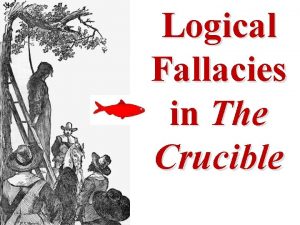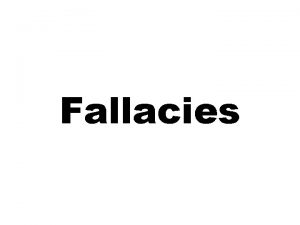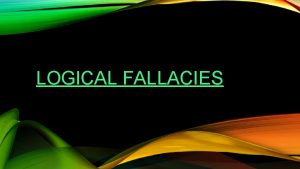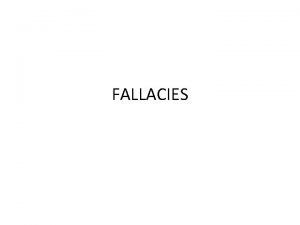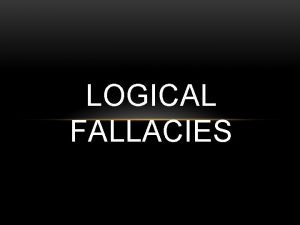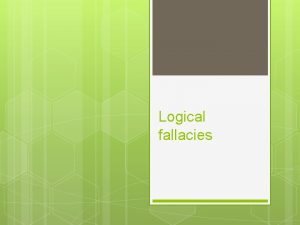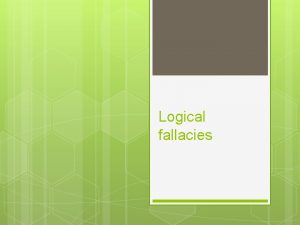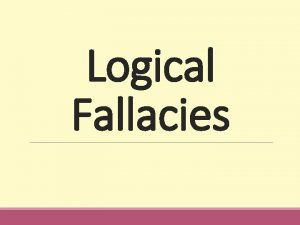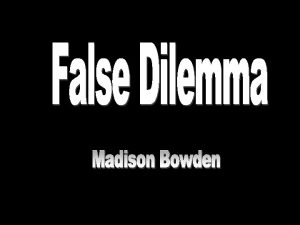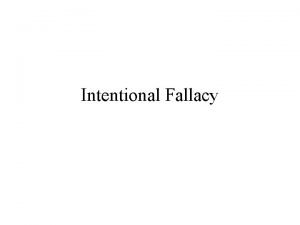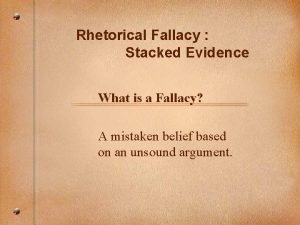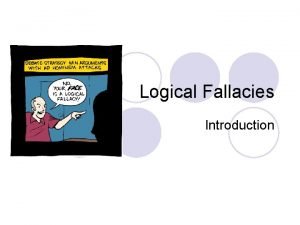Fallacies A fallacy is an invalid conclusion drawn





































- Slides: 37

Fallacies

A fallacy is an invalid conclusion drawn from observation or facts. Fallacies derive from faulty logic/reason. The 2 main causes of fallacy are ignorance and laziness.

Economic fallacies can be distilled down to 5 main errors. 1. Forgetting Costs – Nothing without cost – seen or unseen 2. Forgetting that nothing works in isolation – Both time and place 3. Forgetting that improvements in standard of living can only be measured in the how much we value the goods and services that are produced. 4. Forgetting about individuals. 5. Money is not wealth, it has no intrinsic value, it is only a measure of wealth.

How do economic fallacies impact the economy and you? EQ 4 -3

Fredric Bastiat - French economist and satirist (speaker) Please Read The Broken Window Fallacy 1. What is the larger message of the story? Relate to government spending Disasters War 2. What would Bastait say to people who only look at GDP as a sign of economic growth? 3. Brainstorm reasons why Bastiat would write this story. 4. Who is his intended audience?

The Broken Window Fallacy https: //www. youtube. com/watch? v=g. G 3 AKo. L 0 v. Es https: //www. youtube. com/watch? v=er. JEa. Fp. S 9 ls From the movie the “Fifth Element” https: //www. youtube. com/watch? v=Snzz. WGcd. Mq. Y War, natural disasters, big government spending- don’t help economies

Directions: 1. Read The Essence of “bad economics” and get acquainted to the fallacies on the list. 2. Read news articles and determine which fallacies are associated with the story. 3. Determine if your topic or candidate’s policy are associated with any fallacy. Share

X X X X

Be on the look out!!!!! For fallacies throughout this unit and for fallacies that relate to your topic.

What Fallacy?

What Fallacy?

How do economic fallacies impact the economy and you? EQ 4 -3

Imagine that a law was passed to increase min. wage from $7. 25 per hour to $10. 10

Link the fallacies to the minimum wage laws.

True or False You can exchange $8 for $100 trillion in real usable currency. In other words for only 8 dollars you can become a trillionaire. Click See how

The Money is Wealth Fallacy Prices are metric of wealth but not wealth themselves

What message is the pie-graph attempting to convey to the reader? Is there a flaw with this method?

The Zero-Sum Fallacy https: //www. youtube. com/watch? v=OYy. NY_5 ACFc https: //www. youtube. com/watch? v=q. Sco-x. Fnrpg Aka The Fixed Pie Fallacy The idea that there is a fixed amount of wealth and that wealth cannot be created only redistributed. A gain by one must mean a loss by another. Gains and losses add up to zero.


Comparing a finite resource, like land, to an infinite resource like human creativity and wealth production causes plenty of false assumptions and misplaced anger based on ignorance of basic economic principles.

There is not much more land in America than there was 50 years ago. But there is far more wealth. Since 1960, the total output of the U. S. economy, accounting for inflation, has more than quadrupled. Total physical assets have done likewise.

The art of economics consists in looking not merely at the immediate but at the longer effects of any act or policy; it consists in tracing the consequences of that policy not merely for one group but for all groups.

The Free Lunch Fallacy https: //www. youtube. com/watch? v=k. ZMxvl. Kxyk 0 Tax, inflation, low interest, creative loans, deficit spending, and the debt

The Isolation Fallacy One group doesn’t make or break the economy, profits and business help other businesses

The Immediate Effect Fallacy Look past phase one of economic polices, economic policies live longer than political terms

The Win- Win Fallacy Everything has a level of scarcity, you cannot have your cake and eat it to

The Composition Fallacy What is true for a part doesn’t mean it is true for the whole The Division Fallacy What is average for the whole doesn’t mean it is true for each part

The Fallacy Of Collective Terms

The Protection Fallacy Creative destruction hurts but it is necessary, survival of the fittest and laws of nature. Protecting competitors not competition Protecting those who are on the inside against those on the outside Remember the petition to the candle makers?

The Open Ended Fallacy There can always be more of something good but not at the expense of something else Open space, health, safety

The Chess-Piece Fallacy People are human and cannot be counted on like pieces on the chess board

The Production for its own sake Fallacy Paying someone $200, 000 to dig ditches and to fill them back in will not improve the economy

The Correlation = Causation Fallacy The Post-Hoc Fallacy (false cause, coincidental correlation, correlation not causation): X happened then Y happened; therefore X caused Y

The Single Cause Fallacy

The Starting point and ending point Fallacy Those who use data to attempt to show causation often hand pick starting points and points to support their ideas. For example: “since this bill was adopted murder rates dropped. ” But they may be neglecting to tell the audience that murder rates were dropping before the bill.

The False Dilemma Fallacy It is either this or that Used often to promote extremes Used often to levy false logic against a position. “He is against government spending on education. He is against education. ”

GDP and Fallacy 1. Connect GDP to 1 or more of the 5 main errors of economics that can lead to economic fallacy. Please provide and explanation. 2. Using your fallacy packet fill in the chart (to the right), place an “X” for every fallacy that can occur by using GDP as an indicator. 3. Selection 2 -3 from the chart and give a detailed explanations as to why those particular fallacies relate to GDP
 Invalid vs invalid
Invalid vs invalid Appeal to vanity fallacy
Appeal to vanity fallacy Missing the point
Missing the point Construct an invalid argument using improper transposition
Construct an invalid argument using improper transposition Appeal to authority fallacy
Appeal to authority fallacy Thou shalt not commit logical fallacies
Thou shalt not commit logical fallacies Are ethos and pathos logical fallacies
Are ethos and pathos logical fallacies False cause
False cause Fallacies breaking bad
Fallacies breaking bad Fallacies in academic writing
Fallacies in academic writing Logical fallacies guided notes
Logical fallacies guided notes Lexicons
Lexicons Logical fallacies purdue owl
Logical fallacies purdue owl Fallacy
Fallacy Example of relevance
Example of relevance Fallacies of presumption
Fallacies of presumption Myths and fallacies about non communicable diseases
Myths and fallacies about non communicable diseases Informal fallacy
Informal fallacy To quoque
To quoque Logical fallacy in the crucible
Logical fallacy in the crucible Stacked evidence fallacy
Stacked evidence fallacy Plain folks propaganda in animal farm
Plain folks propaganda in animal farm Fallacy of presumption
Fallacy of presumption Contoh silogisme kategorik
Contoh silogisme kategorik Logical fallacies detector
Logical fallacies detector False analogy
False analogy Fallacies of ambiguity
Fallacies of ambiguity Logical fallacies
Logical fallacies Amphiboly definition
Amphiboly definition Logical fallacies
Logical fallacies Logical fallacy propaganda
Logical fallacy propaganda Purdue owl logical fallacies
Purdue owl logical fallacies Logical fallacies in the media
Logical fallacies in the media Exegetical fallacies
Exegetical fallacies Logical fallacies
Logical fallacies Logical fallacies bell ringer journal
Logical fallacies bell ringer journal Logical fallacies in the crucible
Logical fallacies in the crucible Rhetorical devices vs logical fallacies
Rhetorical devices vs logical fallacies


